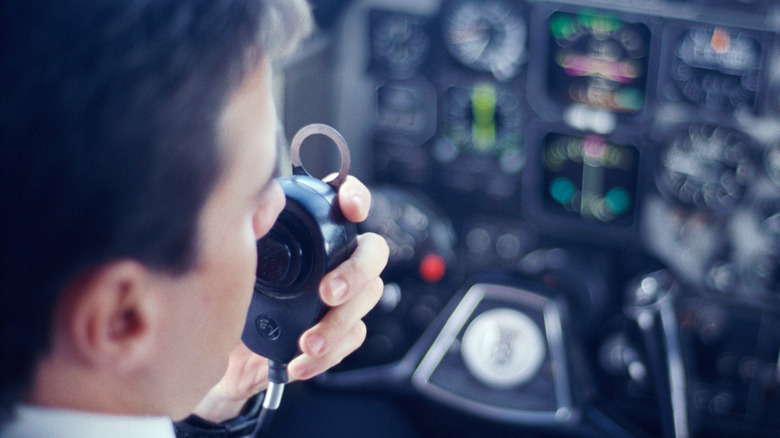You’ve heard it before in plenty of TV shows and movies. A plane is plummeting to the ground or it loses engine power and the pilot says, “Mayday! Mayday! Mayday!” and air traffic control (ATC) immediately jumps into action because they know the aircraft is in danger. A pilot saying “Mayday” three times in succession is globally recognized as the aviation distress call. The word has its roots in the French language as it comes from the phrase “m’aider,” which roughly translates to “help me.” Using something like “Mayday” works better than other distress calls like “SOS” because it’s unmistakable. Saying it three times is even more definitive.
Advertisement
The 1920s saw a rise in air traffic, which meant an internationally recognized distress signal was vital. A radio operator out of Croydon Airport in London named Frederick Stanley Mockford was tasked with devising such a phrase. Since the airport received a lot of traffic from France, he considered a French phrase and landed on m’aider. Sure, pilots could have used SOS, but the consonants could have easily been mistaken for some other similarly sounding consonant, which confuse ATC and other pilots. SOS worked for naval vessels because they communicated with Morse code.
It’s essential that the pilot in trouble repeats the word as a means to limit any sort of confusion. There could be chatter on one of the emergency frequencies–121.5 MHz and 243 MHz– already responding to another Mayday, in which case ATC may have to repeat the word.
Advertisement
There are other distress calls
Mayday is strictly reserved for immediate emergencies, but there are other calls pilots can use to signal less alarming scenarios. It’s not always engines going out and planes falling out of the sky. Sometimes there are mechanical failures where the landing gears or flaps don’t function properly. Mayday is for life-threatening situations and gets priority. Below that, in terms of priority, there’s Pan-Pan. This call is urgent but not life-threatening and is reserved for the previously mentioned mechanical failures. It can also be used in the event of a passenger is experiencing a medical emergency.
Advertisement
Just as there are urgent calls pilots use to relay to ATC, there are urgent calls ATC sometimes needs to relay to pilots. If ATC makes a SECURITE call, it means there’s a hazard around that pilots need to be aware of. Sometimes that might be the weather, including high winds or snow storms, and other times it might be a navigational hazard. It’s a call that alerts the pilot to a hazard that can directly affect an aircraft.
There is an order of operations for Mayday
There’s no doubt that any kind of situation that requires the use of a Mayday call is a stressful and panic-inducing one. When people are panicked, they can forget important information that can save more lives. Despite this, the Federal Aviation Administration (FAA) has a series of steps pilots should follow as a way for ATC to acquire more information.
Advertisement
A call like “Mayday, Mayday, Mayday” or Pan-Pan, Pan-Pan, Pan-Pan will come in, depending on urgency. The station will acknowledge the alert. The type of emergency is explained, and the pilot’s intentions are stated. Other pertinent information like weather, altitude, headings, passengers, etc. are also exchanged. It’s kind of like being on a 911 call. The more information ATC can ascertain, the better prepared emergency services will be when they respond. Modern day airplanes and jets also come with the ability to squawk 7700. This code alerts ATC to an emergency on the aircraft without the pilot having to say anything.
Mayday saves lives
In 1989, United Airlines Flight 232 flying from Denver to Chicago, had to initiate an emergency landing over Iowa when it experienced engine failure in the tail’s engine. The McDonnell Douglas DC-10 lost all hydraulic controls. The pilot called Mayday over the radio and was told to make an emergency landing at the airport in Sioux Falls, Iowa. Emergency crews were able to make the necessary precautions. Unfortunately, no amount of preparation could have saved the lives that were lost in the emergency landing.
Advertisement
It was the plane’s right wing that hit the ground first, then the landing gear. The fore of the plane separated from the rest of it after bouncing on the runway a couple times. Of the 296 aboard, 110 passengers and one crew member lost their lives. Luckily, 2009’s U.S. Airways Flight 1549 had better results. Flight 1549 survived an emergency landing after a flock of geese flew into the Airbus A320 passenger jet.
The birds struck both engines shortly after the flight took off from La Guardia Airport, forcing Capt. Chesley “Sully” Sullenberger to land in the Hudson River. While it was his quick thinking that saved all 155 passengers and five crew members, his immediate Mayday call had emergency services at the scene and prepared to evacuate everyone aboard.
Advertisement








